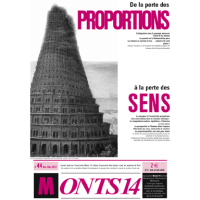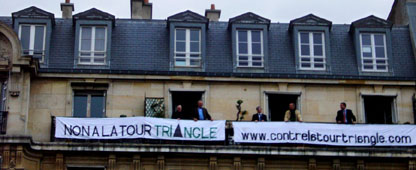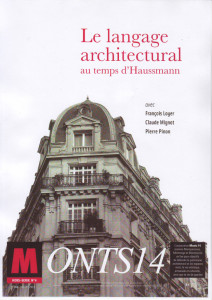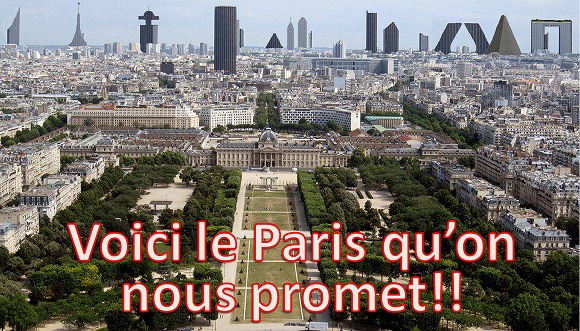
Responding to France Revisited’s call for an opinion article from various opponents to Paris City Hall’s push to approve the construction of a 180-meter (590-foot) high-rise known as the Triangle Tower, Patrice Maire, president of the association Monts 14, stepped up to the plate with the following text, translated here from the original French.
Will Paris Be Modernized or Disfigured?
by Patrice Maire
Ever since he was elected Mayor of Paris in 2001, Bertrand Delanoë has established his popularity though high profile communications with operations such as Vélib, the bike share system, Paris-Plages, the summertime “beach” along the Seine, and a call for the construction of skyscrapers—towers—along the edges of the city.
In 2004 he consulted Parisians on their view of the capital’s urban development: 120,000 people responded and 63% declared themselves to be opposed to the construction of towers. He dropped the idea, particularly since he couldn’t alienate his Green Party allies who were also opposed.
A modernity of thundering rupture with the past

In an opuscule published in 2009, Paris 21e siècle (21st Century Paris), the mayor bellowed that “Paris should know how to impose its modernity in order to maintain its rank.” Indeed, he’s given endless stabs at the Paris landscape. On multiple occasions he has pushed up the height limits in urban regulations: 15 meters (49 feet) higher for architectural signs, unlimited increase for wind turbines, etc. At the end of 2009, he chipped away at the regulated height zone protecting the view of the Arc de Triomphe on the Champs-Elysées and on Rue de Rivoli by accepting the raising of the Samaritaine [Editor’s note: Samaritaine is a former department store occupying choice real estate between Notre-Dame and the Louvre and now owned by LVMH and under renovation/reconversion]. Worse still, he obliges developers with a modernity of thundering rupture, a 180° turn-around with respect to the principles of integration in the urban landscape that have always been written in the City Planning Code.
Delanoë and “old stones”
On November 21, 2011, at the Cévennes Gymnasium in the 15th arrondissement, he said that “the image of Paris is not simply to come to see old stones… we expect Paris to be a dynamic city of the 21st century, not of the 18th or the 19th… we ask it to be a city of heritage and in international competition, intellectually and creatively competitive… the city cannot live and breathe if we have this immobile, stiff, stuck vision…”
Architectural language during Haussmann’s time
 Hearing these unpleasant words about the physiognomy of Haussmann’s Paris is a reminder that some Parisians repudiate it and even see in a “bourgeois culture.” Needless to say, we appreciate a masterpiece more when we understand the context in which it appeared. That was my goal in publishing in May 2012 Special Issue No. 4 of the journal Monts 14 entitled Le langage architectural au temps d’Haussmann, (Architectural Language During Haussmann’s Time), a document that dares to make the comparison with the Renaissance in Florence, Italy in the 15th century.
Hearing these unpleasant words about the physiognomy of Haussmann’s Paris is a reminder that some Parisians repudiate it and even see in a “bourgeois culture.” Needless to say, we appreciate a masterpiece more when we understand the context in which it appeared. That was my goal in publishing in May 2012 Special Issue No. 4 of the journal Monts 14 entitled Le langage architectural au temps d’Haussmann, (Architectural Language During Haussmann’s Time), a document that dares to make the comparison with the Renaissance in Florence, Italy in the 15th century.
The fight against the Triangle Tower
Following the municipal elections of 2008, Mayor Delanoë’s Socialist Party had an absolute majority in the city legislature. He immediately began to push on Parisians plans for skyscrapers at six locations in Paris. On September 25 that year, the Triangle Tower project was presented at City Hall to an audience of dazzled journalists. [Editor’s note: the official website for the Triangle Tower as planned by the architectural firm Herzog & de Meuron can be found here.]
The tower is supposed to make more attractive the Parc des expositions exhibition complex at Porte de Versailles on the southeastern edge of the city (15th arrondissement) by creating hotel rooms, conference halls, a business incubator, etc. In reality, only one large company, of international scope, is interested in occupying space there. Offended at having been left in the dark, Philippe Goujon, mayor (UMP, conservative party) of the 15th arrondissement, declared, “The project disintegrated in my eyes: no hotel rooms, no conference halls, offices for whom?”

Revision of the PLU (Local Urban Plan) for Porte de Versailles
That was before the financial crisis weighed down on the real estate market for office space in 2009. Nevertheless, Anne Hidalgo, Mayor Delanoë’s right hand [Editor’s note: and presumed candidate to replace him in 2014], launched a communications campaign on the theme “Change the image of Paris.”
Two years later, an exhibition about the projected changes took place at the district hall of the 15th arrondissement from June 28 to September 2, 2011. District Mayor Goujon was again in favor of the project. A public inquiry was conducted that fall to gather the comments regarding the proposed development.
During that period, Mont 14 and other associations opposed to the project—Jeunes Parisiens de Paris, ADAHPE, APXV and SOS Paris (the most international and Anglophone of these groups)—formed the Collective Against the Triangle Tower.
Collective Against the Triangle Tower gains traction
These efforts began to bear fruit. Having gathered the observations 300 people as well as 1700 signatures on a petition by Monts 14, the commissioner of the inquiry noted in his official report of April 2012, along with remarks favorable to the tower, three reservations to the project: concerning traffic, the shadow caused by the tower and the partial amputation of the Parc des expositions. In particular, the report asked Mr. Delanoë to justify that the project would not weaken the role of the exhibition complex in terms of international competition.
Indeed, the tower as then planned would amputate from 6000 square meters (65000 square feet) of the exhibition complex’s Hall 1, a unique window to the world for the major French automobile manufacturers during the Automobile Show held here every two years in the fall. In support of the Automobile Show, the Collective Against the Triangle Tower demonstrated at the show’s opening on September 29, 2012. The demonstration made the front page of the newspaper Le Parisien. The newspaper Le Figaro followed suit. Another demonstration, on the occasion of the Boat Show, took place on December 8. This time the Collective was joined by representatives of the political parties MODEM, Jeunes democrats, EELV, Debout la république and Parti de Gauche.
A turning point in the fight
Their presence represents a turning point in the fight. Indeed, there are prejudices that are difficult to combat. Faced with the penury of reasonably priced housing, Parisians often see towers in a positive light. Mr. Delanoë finds it easy to toady to their anxiety by luring them with the promise of mixed-use towers with space for both business and lodging. We have repeatedly remarked that as far as lodging goes such high-rises are expensive to build per square meter and their maintenance costs are excessive (500€ per month for a 3-room apartment in the Olympiades complex on the southwest edge of Paris). Their primary purpose is apparently not to created affordable housing for inhabitants of the city.
Delanoë’s totem
The sole interest for constructing a building such as the Triangle Tower in Paris is its totemic value. A massive building overshadowing the city can have communications value for a large company or for the mayor of Paris. Mr. Delanoë would like to be identified with the totem of the Triangle Tower. However, there’s a far more emblematic vision to consider, that of the Great Boulevards, of stone buildings, of Haussmannian rooftops, of the Galeries Lafayette, of diversity and cultural richness.
It’s the attraction of that vision that explains why Paris is the most world’s most visited city. Such attractiveness is France’s good fortune, but it’s one that risks being wasted. Towers are now commonplace; worldwide, about 15000 towers rise over 100 meters (328 feet). Towers draw our attention like a lightning rod attracts lightning. Building towers would interfere with the Paris skyline and make it commonplace.

Mr. Delanoë has had to regroup following the reservations put forth last year by the commissioner of the inquiry. Still attached to the hotel rooms and convention halls that he had wanted housed in the tower, he’s now looking to build them elsewhere within the same sector. Mr. Delanoë has now launched another public inquiry in an attempt to “modernize” the Parc des Exposition with the creation of hotel rooms and meeting halls. That absolutely does not justify the construction of the Triangle Tower as an office tower!
Let’s refuse to let Paris be disfigured
The Triangle Tower will be voted on by the Council of Paris on the July 18, 2013. If approved, the association Monts 14 will bring the matter before the administrative tribunal on the grounds that this project is not in the public interest. We will then do our part in ensuring that the debate about the physiognomy of Paris is among the major issues of next year’s municipal elections.
Whether you live in France, in the United States or elsewhere around world, we invite all those who love Paris to support this fight by signing the petition found here, writing to the major or to your local representative in Paris, joining an association, attending our debates and demonstrations, and letting it be known that you refuse to let Paris be disfigured.

Patrice Maire
President of Monts 14
Patrice Maire is president of the association Monts 14 and editor of the journal produced by the association. For information about the association and its efforts to halt the construction of the Triangle Tower see www.monts14.com.
Mont 14 is one of the associations that grouped under the banner Collective Against the Triangle Tower. Another among them is SOS Paris, which has many foreign and English-speaking members.
Patrice Maire’s text in France was translated for France Revisited by Gary Lee Kraut, April 2013.
The opinion expressed above is presented to give a sense of the debate surrounding the Triangle Tower and does not necessarily reflect that of France Revisited.
For France Revisited’s introduction to the subject of the Triangle Tower and of other high-rises in Paris read: Paris on the Edge: Does the French Capital Need High-Rises and Towers to Stay Relevant.



I come to Paris twice a year for four weeks. It is the utter beauty of Paris than continues to draw me: the wonderful Haussmann design and architecture of Paris; the Seine; the large opulent and hidden small neighborhood parks. I spend my days just wandering, walking, exploring and being rejuvenated.
I am not wealthy and it can be a struggle to continue these holidays, but there is nowhere else I yearn to spend my time. I take an apartment and just imbibe Paris.
I spend no time at La Defense and actively avoid the ‘ modern ‘ business district, other than to pass through it, preferably by Metro, on my way to yet more beauty that to me is Paris.
The thought of tower in Paris is abhorrent and to me enters the concept if distraction. Why us it that some men need to impose their ‘ mark ‘ on the sublime and in so doing taint and destroy.
Please add my name to any petitions you instigate. I will be in Paris for September and will gladly that part, as a foreigner who adores Paris, I will gladly take part in any demonstrations you plan.
Shannon Bellett
Bonjour Shannon,
Thanks for your commment. I’m sure that many frequent visitors to Paris share your view. The link to the petition referred to in Patrice Maire’s opinion piece is the following:
http://www.petitions24.net/signatures/refusons_la_tour_triangle_a_la_porte_de_versailles/
The associations Mont 14, SOS Paris and Collective Against the Triangle Tower (see links in the article) can best advise you on the best way to take part in their fight against the towers from home or when in Paris.
Gary